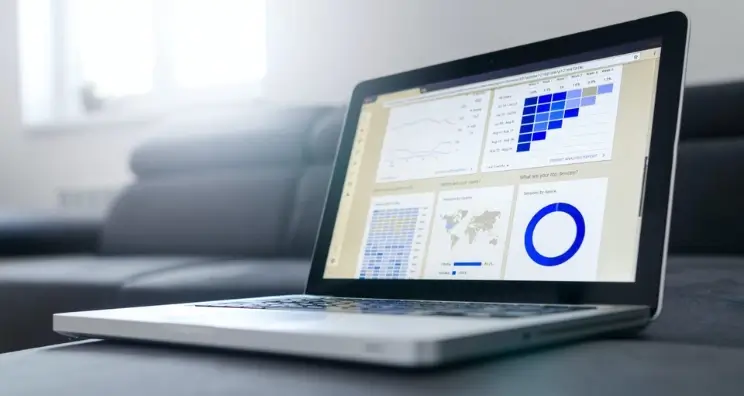If you’re going to be sending out sales proposals this year, using a microsite content experience platform could allow you to elevate your pitching and land major deals.
Unlike static documents like Word files and PDFs, microsites are living breathing websites — in miniature. And they’re perfect for those that want a more exciting way to engage with prospects.
Of course, effective pitching is as much an art form as a science. But to get luck on your side, you should take a look at the following sales proposal design guidelines we’ve put together to help you deliver a beautifully designed pitch every time.
Whether you’re responding to a request for proposals (RFP) or are proactively pitching for business, follow these tips to give yourself the best chance of success:
Don’t neglect the titles
The first things your users will notice when they click into your microsite will be your title headings, both for your site and for each of the pages it contains.
When prospects find sites organically through search engines like Google, the meta title and metadescription are your first opportunity to make the right impression. So these are crucial elements to address in your sales proposal design.
Most sales proposal microsites are going to be private resources. However, if they are not, then you should make sure that the SEO titles are strong before working on the actual on-site content.
For titles, we recommend going through each heading and subheading of the microsite to make sure that each describes the section that follows it well. Ideally, you want to be constantly leading the reader into finding out more about you and your organization.
Small paragraphs are best
Remember that microsites are web properties and that they’re going to be read from a computer — whether that’s a desktop or smartphone.
UX research has confirmed that people don’t really read online — they skim — and for sales proposal design the same best practices apply! With that in mind, it’s best to write your sales proposals using short paragraphs. Keep them to three or four sentences at most.
Remember that those reading your sales proposals are likely to be serving on busy purchasing committees often lacking the time to go through every line of a digital sales proposal in detail.
To capture their attention make their job as easy as possible:
- Write in short paragraphs.
- Use a font that is easily readable.
- Draw their attention to key elements of the proposal by highlighting key phrases
- Use visually attractive elements such as pull quotes and breakout boxes
Anything that you can do to break up the proposal and make it easier to read is going to make your sales proposal more engaging, potentially improving your chances of a successful bid!
Make your microsite easy to navigate
Frequently, those using a content experience platform like Zoomforth to send out sales proposals are targeting multiple recipients at the same time. Your average purchase evaluation committee might comprise:
- A finance manager (who will care about the financial nuts and bolts)
- An account manager
- A procurement specialist who might be familiar with your competitors and how your offer compares to theirs
These recipients are going to be interested in different parts of the microsite. So it’s your job— or your designers— to make it as easy as possible to jump to the part of the site that interests them.
You can:
- Include a clear navigation bar at the top of the microsite. Make sure that it’s not too cluttered or long. We recommend making sure that it all fits into one line. You should go through this navigation to make sure that it doesn’t contain unnecessary pages.
- Adjust the CSS file in your microsite control panel to control the look and feel of the navigation bar. Again, your goal here is to make sure that it’s visually attractive and provides a clear guide to the site. You don’t want to overwhelm.
Another best practice you can utilize throughout your microsite is to include lots of internal links. Those are links between different pages. Make sure to also pick the best anchor text (the words that contain the link).
Don’t overwhelm visitors
You want to make sure that navigating through the microsite is an enjoyable experience. If your recipients are going to be evaluating the contents of the site in detail, then this is particularly true.
The less mental resistance your design generates, the easier it’s going to be for people to engage them with your message. With this in mind, follow design best practice by ensuring that your website makes good use of whitespace. We’ve talked about this in our design best practices guidelines. You can check those out here.

Mix up your content
One of the great advantages of microsites compared to traditional formats for sending sales proposals is that they are live documents. You can update them at any time. That said, in practice, you’ll likely want to finish editing them carefully before you hit the publish button.
Another major plus is that they can be used to embed a lot of different content. Besides using text, don’t be afraid to push the boat out in terms of the content that you embed in your proposal.
Even if to date your sales presentations have mostly been bullet points and blocks of text, this is a chance for you to change things up — and provide readers with a more lively content experience.
In addition to text you can include:
- Photography: They say that a picture speaks a thousand words. Consider adding high quality imagery throughout your sales proposal. While there are plenty of stock image libraries available online, many find that using their own photographs adds that extra sense of authenticity.
- Infographics: You’ll probably want to be using statistics and figures to make the case for doing business with you in your sales proposals. The trouble with rows of numbers is that they tend to put people to sleep! Enter stage data visualization! You don’t need to subscribe to a complicated data visualization tool to present facts and figures engagingly. In fact, you just need to know how to create simple charts and graphs (like pie charts) and add them to your microsite. While your target audience is going to want to know what you can do for them, it’s important to back up your claims with data so that your prospects can see you’re more than just talk!
- Audio and video: Using Zoomforth, you can embed HTML code into your microsites. This opens up the types of content that you can carry. For instance, you could embed an audio file for listening or you could embed video objects from YouTube. You can also add documents into your microsites. So if there’s a particular place where you think it would be helpful to prompt users to download a static document, then this can be achieved too. The good thing about microsites is that they allow you to blend dynamic content and static content. Choose the mix that best aligns with your sales objectives.
Don’t stuff the fold
Content marketers have repeatedly been told not to add key content below the fold. That’s the part of the site that loads when you open a web page. But there are exceptions.
For effective sales proposal design, we recommend making an effort to prioritize content in a logical order and to include the key information towards the top of the page. But you don’t need to ruin the credibility of your microsite by adding too much. After all – there’s only so much information that can fit onto a computer screen!
Keep it proposal specific
Microsites are great assets for delivering information in a package to consumers.
Nevertheless, most businesses also operate a company website. That might have a lot of information that could be of interest to your sales prospects, too. So how can you use both effectively?
Our advice, to achieve the most effective sales proposal design possible, is to keep the contents of the microsite concise. For instance, it might be helpful to include your customer history in the microsite. But you could equally just put a link to that page on your company site in the navigation menu.
Before adding content to the microsite, think about whether it already exists elsewhere. If it does, do you risk cluttering up the microsite by duplicating it? Or could you just point users to an existing (offsite) resource?
Correct branding right from the outset
Just as you’ll want to develop a template to bake in company branding to each microsite, you’ll also probably want to make sure that each microsite that rolls out your door contains some standardized sections.
Again, you should consider whether it makes more sense to include these in the microsite or to link off to the company website, LinkedIn, or some other resource.
If they belong on the website, and you’re going to need them in each proposal, then you could insert these into a template.
For example, suppose that you know that each bid of a certain type is going to carry the same set of terms and conditions or a common disclaimer. Why not add that information into the footer of a template? That can then be duplicated as required and updated the moment they change.
Get (at least) two pairs of eyes on every page
Just because you’re building your sales proposals online now doesn’t mean that only one person needs to be involved. In fact, we highly recommend building a team comprising everything from writing specialists through to graphic designers. Be clear who does what.
Whatever the makeup of your microsite building team, you’ll want to make sure that everything is reviewed by somebody else. Take a look at our QA checklist to see exactly the kind of thing you should be looking out for.
When you’re building out a sales proposal as as microsite you’ll specifically want to:
- Have somebody double check all the facts and figures cited
- Make sure the target client’s name is spelled correctly
- Make sure that any details cited about the client, or your competitors, are accurate
How you go about this proofreading process is up to you. A checklist is never a bad system for making sure that everything gets ticked off and properly QA’d before it goes out the door.
Towards more effective sales proposals
Sending out sales proposals as microsites instead of documents can be a winning formula for success!
However, with powerful potential comes great responsibility! You should follow through these tips in order to make sure that every proposal that goes out the door has the maximum probability of winning business for your firm.
To learn more about how to use Zoomforth in your organization, click here.



